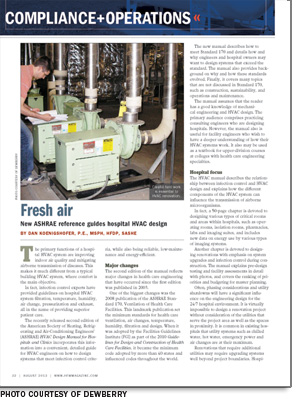 The primary functions of a hospital HVAC system are improving indoor air quality and mitigating airborne transmission of diseases. This makes it much different from a typical building HVAC system, where comfort is the main objective.
The primary functions of a hospital HVAC system are improving indoor air quality and mitigating airborne transmission of diseases. This makes it much different from a typical building HVAC system, where comfort is the main objective.
In fact, infection control experts have provided guidelines on hospital HVAC system filtration, temperature, humidity, air change, pressurization and exhaust, all in the name of providing superior patient care.
The recently released second edition of the American Society of Heating, Refrigerating and Air-Conditioning Engineers' (ASHRAE) HVAC Design Manual for Hospitals and Clinics incorporates this information into a convenient, detailed guide for HVAC engineers on how to design systems that meet infection control criteria, while also being reliable, low-maintenance and energy-efficient.
Major changes
The second edition of the manual reflects major changes in health care engineering that have occurred since the first edition was published in 2003.
One of the biggest changes was the 2008 publication of the ASHRAE Standard 170, Ventilation of Health Care Facilities. This landmark publication set the minimum standards for health care ventilation, air changes, temperature, humidity, filtration and design. When it was adopted by the Facilities Guidelines Institute (FGI) as part of the 2010 Guidelines for Design and Construction of Health Care Facilities, it became the minimum code adopted by more than 40 states and influenced codes throughout the world.
The new manual describes how to meet Standard 170 and details how and why engineers and hospital owners may want to design systems that exceed the standard. The manual also provides background on why and how these standards evolved. Finally, it covers many topics that are not discussed in Standard 170, such as construction, sustainability, and operations and maintenance.
The manual assumes that the reader has a good knowledge of mechanical engineering and HVAC design. The primary audience comprises practicing consulting engineers who are designing hospitals. However, the manual also is useful for facility engineers who wish to have a deeper understanding of how their HVAC systems work. It also may be used as a textbook for upper-division courses at colleges with health care engineering specialties.
Hospital focus
The HVAC manual describes the relationship between infection control and HVAC design and explains how the different components of the HVAC system can influence the transmission of airborne microorganisms.
You may also like |
| HVAC equipment for off-site care |
| Health care ventilation evolution |
| HVAC control for operating rooms |
| |
In fact, a 50-page chapter is devoted to designing various types of critical rooms and areas within hospitals, such as operating rooms, isolation rooms, pharmacies, labs and imaging suites, and includes new data on energy use by various types of imaging systems.
Another chapter is devoted to designing renovations with emphasis on system upgrades and infection control during construction. The manual explains pre-design testing and facility assessments in detail with photos, and covers the ranking of priorities and budgeting for master planning.
Often, phasing considerations and utility shutdowns will have a significant influence on the engineering design for the 24/7 hospital environment. It is virtually impossible to design a renovation project without consideration of the utilities that serve the project area as well as the spaces in proximity. It is common in existing hospitals that utility systems such as chilled water, hot water, emergency power and air changes are at their maximum.
Renovations that require additional utilities may require upgrading systems well beyond project boundaries. Hospitals usually are strapped for floor space, especially in mechanical rooms. Thus, it generally is difficult to replace devices such as air handling units in situ because of 24/7 operations. A new mechanical room may be required to install a new air handling unit and associated equipment. After this equipment is all online, the old equipment and mechanical room can be cleaned and repurposed.
Careful phasing is required to minimize disruption to patients and hospital operations during construction. The highest probability of airborne infection comes from construction activities within existing hospitals; as a result, infection control risk assessments and interim life-safety measures receive extensive attention in a chapter on operations and maintenance, written by a hospital engineer.
Unlike many facilities, hospitals have year-round cooling loads, regardless of their location. Numerous factors unique to hospitals drive that cooling demand. For instance, hospital buildings often have a low surface-to-volume ratio and they are less impacted by ambient weather. Moreover, hospitals contain numerous systems and devices that produce significant amounts of heat, such as imaging systems, refrigerators and intense lighting.
The chapter on utilities focuses on central energy plants, which are typical of most health care facilities. The design of central chilled water plants is described in the context of the performance objectives for the HVAC system within the hospital. The pluses and minuses of various energy-conservation strategies such as chilled beams, air and water economizers, and energy recovery systems are weighed.
A deeper dive
The ASHRAE manual is written for experienced mechanical engineers who wish to dive deeply into health care engineering. Toward that end, a good hospital HVAC system must meet all performance parameters (e.g., air quality, air changes, filtration, temperature and humidity), be reliable, minimize maintenance requirements and be energy-efficient.
The manual discusses the delicate balance required to meet these objectives while also meeting stringent construction budgets. Additionally, a chapter on sustainability includes a significant section on the environment of care. Generally, patients are much more sensitive than the general population in terms of the impact of temperature, humidity and air velocity. Moreover, each area of the hospital likely will see a wide variety of patient sizes, ages and acuity, requiring the HVAC system to be highly flexible.
The surgery department is the economic engine for most hospitals. It is also the department that generates the largest number of complaints about temperature and humidity. Humidity is probably the number one cause of HVAC complaints in health care.
Many of these complaints, and all too often the fixes, are generated by a lack of understanding of psychrometrics. Unfortunately, the general public, operating engineers and even many consulting engineers lack the deep understanding of psychrometrics needed to design, build and operate HVAC systems that meet the demanding requirements of surgeons.
The manual's section on operating rooms also goes into considerable detail about meeting the low temperature and humidity desired by most surgeons. While ASHRAE S-170 specifies that operating room HVAC systems be designed for a temperature of 68 degrees Fahrenheit, most surgeons want the temperature considerably lower than that. Thus, it is essential to have an understanding of how hospital systems work and the impact that small changes in chilled water temperature can have on supply air temperature and humidity.
Such energy conservation strategies jeopardize obtaining the exact temperature, humidity and air change requirements in the surgery area, resulting in complaints by the surgery staff.
Other key sections of the manual include:
• A chapter on air handling and distribution systems that includes 60 pages detailing the various components of typical health care HVAC systems with control schematics and descriptions of the nuances required to provide a high-performing and efficient HVAC system.
• Chapters on the business of health care, disaster planning and emergency management, and operations and maintenance provide important background for any consulting engineer wishing to have a deep understanding of all aspects of hospital operations that affect engineering systems. The better a consultant understands his or her clients' needs, the more helpful the consultant can be.
• A chapter on utilities that describes the design of boiler, chiller and emergency power systems to serve hospitals. Many hospitals desire HVAC and electrical systems that handle a wide variety of disasters. Cafeterias may be converted to emergency holding rooms. Patients may have unknown contagious diseases. Chemical spills may require showering for scores of people. Power outages can last for days. It is the responsibility of HVAC engineers to guide owners to make cost-effective decisions that meet their unique requirements.
New data are presented in the manual for energy use and heat output by various types of imaging systems. The data are based on ASHRAE's research project on Method of Testing and Reporting of Energy Use by Medical Equipment. Through practical experience, the authors found that each of the three areas of an imaging suite — the equipment, control and patient rooms — needs its own thermostat and reheat box for individual temperature control. This is another example of a design consideration not specified in S-170 but found by the authors to be important in practice.
The design manual also is based on the highly successful ASHRAE Learning Institute classes on Healthcare Facilities: Practices for Design & Application. This course has been taught to more than 1,500 students at national and international ASHRAE meetings.
Finally, many associations representing pharmacists, material processing personnel and operating room nurses, have produced guidelines for temperature, humidity and air quality in their specific departments. This manual describes how to design the HVAC system to meet these requirements.
Pharmacies, in particular, require careful and unique engineering practices to meet demanding air quality and pressurization requirements.
A broad approach
The HVAC Design Manual for Hospitals and Clinics took a broad approach to providing hospital designers, consulting engineers and facility managers with this comprehensive resource.
In fact, some of the design manual authors also have been involved in revisions to the 2014 ASHRAE Handbook's HVAC applications chapter on health care facilities. The authors also have considered other valuable documents such as the American Society for Healthcare Engineering's commissioning guidelines and ASHRAE Standard 188, Prevention of Legionellosis Associated with Building Water Systems, as well as various other important guides from the U.S. Green Building Council, Centers for Disease Control and Prevention, and National Institutes of Health.
The results of this work now are available to the entire industry.
Dan Koenigshofer, P.E., MSPH, HFDP, SASHE, is vice president of health care engineering for Dewberry, Fairfax, Va. He is a member of ASHRAE Technical Committee 9.6, Health Care, and was the editor-in-chief and a significant contributor to the HVAC Design Manual for Hospitals and Clinics. He can be contacted at dkoenigshofer@dewberry.com.
| Sidebar - Recommendations from ASHRAE's design manual |
| The American Society of Heating, Refrigerating and Air-Conditioning Engineers' (ASHRAE) HVAC Design Manual for Hospitals and Clinics (second edition) accepts ASHRAE Standard 170, Ventilation of Health Care Facilities, as a minimum standard for ventilation of health care facilities and provides detailed explanation and analyses of various recommendations for best practice. Some of the basic rules that came out of the publication include:
|
| Sidebar - New edition adds focus to efficient operations |
| In the spring of 2010, the American Society of Heating, Refrigerating and Air-Conditioning Engineers (ASHRAE) Technical Committee 9.6, Health Care, approved the formation of a group to write a new HVAC Design Manual for Hospitals and Clinics. Over the next three years, the authors met numerous times and traded drafts of each chapter among themselves and posted them on a Google site for interested reviewers. Additionally, five open meetings were held at national ASHRAE conferences to obtain valuable and often controversial input. All of the authors were familiar with the first version of the manual published in 2003, but over time decided that the manual would flow better if it were completely rewritten and fully edited by a small group. With these changes also came an increased emphasis on HVAC efficiency. At the time the first version was written, the general approach toward hospital engineering was "more is better" with regard to filtration, air changes and other variables. In 2013, however, there is tremendous pressure to minimize first cost and operating costs. Engineering choices and investments are evaluated like all other financial investments, thereby requiring design engineers to have a good understanding of the first and ongoing costs of the systems. While the manual is not a consensus document, most of the authors are active ASHRAE members from around the United States and Canada. Each volunteer received assistance and reviews by their associates as well as internally by the committee. The design manual is written in the language of recommendations for best practices and is not intended to be adopted as code. |
| Sidebar - Buying a copy of the manual |
| The American Society of Heating, Refrigerating and Air-Conditioning Engineers' (ASHRAE) HVAC Design Manual for Hospitals and Clinics (second edition) provides in-depth design recommendations based on best practices and presents proven, cost-effective and reliable solutions that result in low maintenance cost and high reliability. It can be purchased for $99 by ASHRAE members and $115 for the general public. For more information, contact ASHRAE's customer contact center at 800-527-4723 (United States and Canada) or 404-636-8400 (worldwide), or log on to www.ashrae.org/bookstore. |





